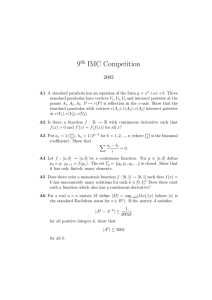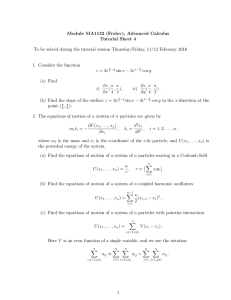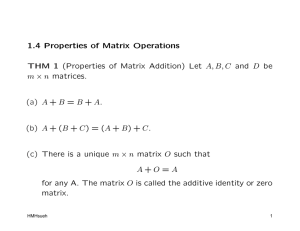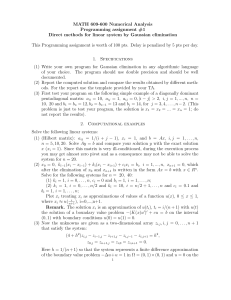COMPLETELY CONTRACTIVE MAPS BETWEEN -ALGEBRAS W. T. SULAIMAN
advertisement
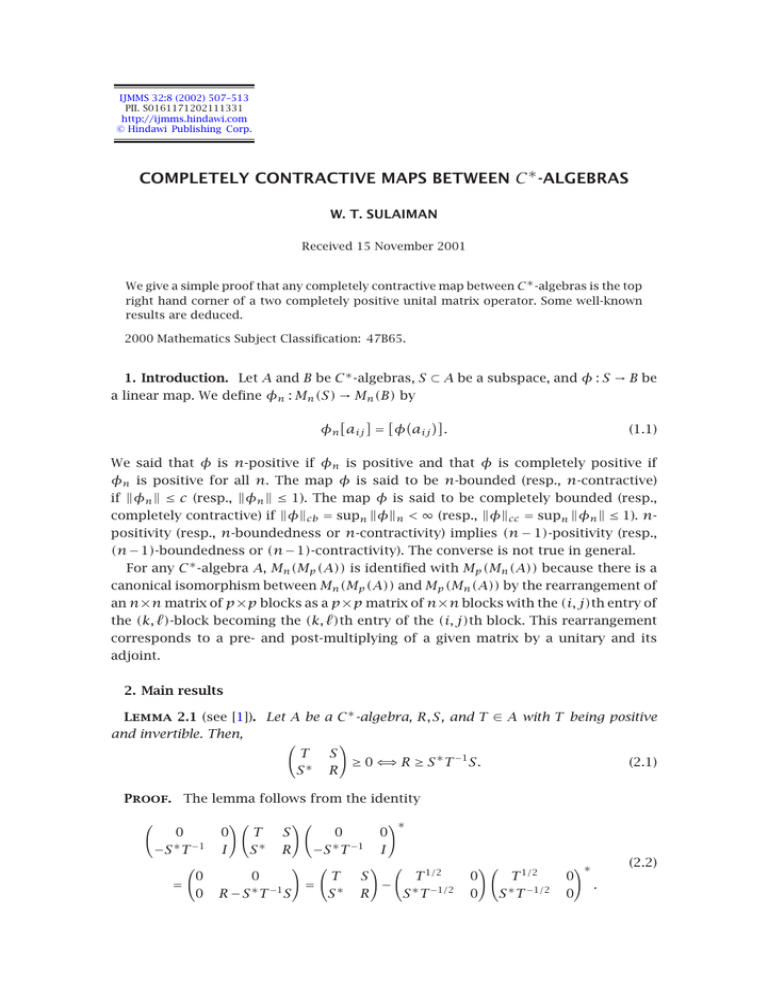
IJMMS 32:8 (2002) 507–513 PII. S0161171202111331 http://ijmms.hindawi.com © Hindawi Publishing Corp. COMPLETELY CONTRACTIVE MAPS BETWEEN C ∗ -ALGEBRAS W. T. SULAIMAN Received 15 November 2001 We give a simple proof that any completely contractive map between C ∗ -algebras is the top right hand corner of a two completely positive unital matrix operator. Some well-known results are deduced. 2000 Mathematics Subject Classification: 47B65. 1. Introduction. Let A and B be C ∗ -algebras, S ⊂ A be a subspace, and φ : S → B be a linear map. We define φn : Mn (S) → Mn (B) by φn aij = φ aij . (1.1) We said that φ is n-positive if φn is positive and that φ is completely positive if φn is positive for all n. The map φ is said to be n-bounded (resp., n-contractive) if φn ≤ c (resp., φn ≤ 1). The map φ is said to be completely bounded (resp., completely contractive) if φcb = supn φn < ∞ (resp., φcc = supn φn ≤ 1). npositivity (resp., n-boundedness or n-contractivity) implies (n − 1)-positivity (resp., (n − 1)-boundedness or (n − 1)-contractivity). The converse is not true in general. For any C ∗ -algebra A, Mn (Mp (A)) is identified with Mp (Mn (A)) because there is a canonical isomorphism between Mn (Mp (A)) and Mp (Mn (A)) by the rearrangement of an n×n matrix of p×p blocks as a p×p matrix of n×n blocks with the (i, j)th entry of the (k, )-block becoming the (k, )th entry of the (i, j)th block. This rearrangement corresponds to a pre- and post-multiplying of a given matrix by a unitary and its adjoint. 2. Main results Lemma 2.1 (see [1]). Let A be a C ∗ -algebra, R, S, and T ∈ A with T being positive and invertible. Then, T S ≥ 0 ⇐⇒ R ≥ S ∗ T −1 S. (2.1) S∗ R Proof. The lemma follows from the identity 0 ∗ −1 −S T 0 = 0 ∗ 0 0 −S ∗ T −1 I 0 T S T 1/2 = − R − S ∗ T −1 S S ∗ T −1/2 S∗ R 0 I T S∗ S R 0 0 T 1/2 S ∗ T −1/2 ∗ 0 . 0 (2.2) 508 W. T. SULAIMAN Let φ : A → B be a linear map. We denote by φ∗ : A → B the linear map defined by ∗ φ∗ (a) = φ a∗ . (2.3) Let S(A) be the linear subspace of M2 (A) given by S(A) = λ b a : a, b ∈ A, λ, µ ∈ C . µ (2.4) Let Φ : S(A) → S(B) be defined by a λ = µ φ∗ (b) λ Φ b φ(a) . µ (2.5) Theorem 2.2. The map φ is n-contractive which implies Φ is n-positive. Proof. Let λij X = bij + aij ∈ Mn S(A) . µij (2.6) We may identify X with λij Y= bij a ij . µij (2.7) Therefore, Y is positive which implies [λij ] and [µij ] are positive in Mn (C). Since Y ≥ 0 if and only if Y + (1/m)I > 0 for every m ∈ I, we may assume that [λij ] and [µij ] are invertible. We have λ a ij ij ≥0 a∗ µij ji aij λij ⇐⇒ ∗ ≥ 0, via identification aij µij ∗ −1 λij aij , by Lemma 2.1 ⇐⇒ µij ≥ aij −1/2 , ⇐⇒ I ≥ µij aij λij λij aij µij , where µij = µij ∗ ⇐⇒ I ≥ λij aij µij λij aij µij −1/2 λij = λij COMPLETELY CONTRACTIVE MAPS BETWEEN C ∗ -ALGEBRAS 509 ∗ λij aij µij ⇐⇒ 1 ≥ λij aij µij 2 ⇐⇒ 1 ≥ 0 λij aij µij ⇐⇒ 1 ≥ λij aij µij n λus ast µtr ⇐⇒ 1 ≥ 0 s,t=1 u,r n λus ast µtr ⇐⇒ 1 ≥ φn s,t=1 u,r n λus φn ast µtr ⇐⇒ 1 ≥ s,t=1 u,r ⇐⇒ 1 ≥ λij φ aij µij 2 ⇐⇒ 1 ≥ λij φ aij µij ∗ ⇐⇒ 1 ≥ λij φ aij µij λij φ aij µij ∗ λij φ aij µij ⇐⇒ I ≥ λij φ aij µij ∗ −1 ⇐⇒ µij ≥ φ aij λij φ aij φ aij λij ≥0 ⇐⇒ ∗ µij φ aij φ aij λij ≥ 0, via identification ⇐⇒ φ∗ a∗ µij ji λij aij ≥ 0. ⇐⇒ φn a∗ µij ji (2.8) This completes the proof of the theorem. Theorem 2.3. Let φ : E → B be a map from a selfadjoint subspace E of a C ∗ -algebra A into a C ∗ -algebra B. Define a map Ψ : S(E) → B by λ Ψ b (i) (ii) (iii) (iv) The The The The map map map map a = (λ + µ)I + φ(a) + φ∗ (b). µ φ is n-contractive ⇒ Ψ is n-positive. Ψ is 2n-positive ⇒ φ is n-contractive. φ is completely contractive ⇒ Ψ is completely positive. Ψ is n-positive ⇒ φn ≤ 2. (2.9) 510 W. T. SULAIMAN Proof. (i) Define maps Φ : S(E) → S(B), δ : M2 (B) → B by Φ λ b a λ = µ φ∗ (b) a δ c φ(a) , µ b = a + b + c + d. d (2.10) The map Φ is n-positive by Theorem 2.2. As δ is n-positive (in fact it is completely positive), then Ψ = δ ◦ Φ is n-positive. (ii) There are two methods to prove (ii). Method 1 (see [4]). Via identification, we have λij Ψn ∗ aij aij ∗ = λij + µij I + φn aij + φn bij , µij λij , µij ∈ Mn (C); (2.11) aij , bij ∈ Mn (A). Let [aij ] ≤ 1, we want to show that φn [aij ] ≤ 1. Now In aij ≤ 1 ⇒ ∗ aij In 0 ⇒ 0 ∗ aij aij ≥0 In 0 0 0 0 0 0 0 0 aij 0 ≥0 0 In In 0 Ψn 0 0 ⇒ 0 0 Ψ n ∗ aij 0 In ⇒ ∗ ∗ φn aij aij 0 0 ≥0 0 0 Ψn 0 In Ψn 0 φn aij ≥0 In ⇒ φn aij ≤ 1 ⇒ φn ≤ 1. (2.12) COMPLETELY CONTRACTIVE MAPS BETWEEN C ∗ -ALGEBRAS 511 Method 2. Since Ψ2n = δ2n ◦ Φ2n and Ψ2n , δ2n are both positive, then Φ2n is also positive. As Φ2n is unital, then Φ2n ≤ 1. Hence Ψ2n ≤ δ2n Φ2n = 2 · 1 = 2. We identified λij bij and write aij ⊗ Mn µij λij bij H with B H aij ⊗ Mn ←→ µij A A , K B , K (2.13) (2.14) (2.15) where H = λij , K = µij , A = aij , B = bij , H, K ∈ Mn , A, B ∈ Mn (A); H A H φ(A) H A Ψ2n ⊗ M2 ⊗ M2 = δ2n Φ2n ⊗ M2 = δ2n K B K φ∗ (B) B K φ(A) ⊗ M2 H ⊗ M2 H φ(A) × 4; ←→ δ2n = φ(B) ⊗ M2 K ⊗ M2 K φ∗ (B) 0 A φn (A) = Ψ2n ⊗ Mn 0 0 0 0 A = Ψ2n 0 0 ⊗ Mn = 4A ⇒ φn ≤ 1. 0 4φn (A) = 4 0 (2.16) (iii) The proof of (iii) is obvious. (iv) Via identification, we have A = H + K + φn (A) + φ∗ n (B) K 0 A 0 A φn (A) = Ψ2n = δn ◦ Φn 0 0 0 0 0 A = δn Φn 0 0 ≤ 2A ⇒ φn ≤ 1. Ψ2n H B (2.17) 3. Applications Theorem 3.1 (see [2]). Let E be a linear subspace of a C ∗ -algebra and let B be a commutative C ∗ -algebra. Let φ : E → B be a linear map. If φ is contractive, then it is completely contractive. 512 W. T. SULAIMAN Proof. Define a map Ψ : S(E) → B by Ψ λ b a = (λ + µ)I + φ(a) + φ∗ (b), µ φ is contractive ⇒ Ψ is positive (Theorem 2.3) (3.1) ⇒ Ψ is completely positive [1, Proposition 1.2.2] ⇒ φ is completely contractive (Theorem 2.3). Theorem 3.2 (see [4, Theorem 1.1.13]). Let E be a closed selfadjoint subspace of a C -algebra. Let B be a commutative C ∗ -algebra. Let Φ : E → Mn (B) be a linear map. If Φ is n-positive then, it is completely positive. ∗ The following theorem is a generalization of Theorem 3.2. Theorem 3.3. Let E be a selfadjoint subspace of a C ∗ -algebra. Let B be a commutative C ∗ -algebra. Let φ : E → Mn (B) be a linear map. If φ is n-contractive then, it is completely contractive. Proof. Define a map Ψ : S(E) → Mn (B) by λ Ψ b a = (λ + µ)I + φ(a) + φ∗ (b), µ φ is n-contractive ⇒ Ψ is n-positive (Theorem 2.3) (3.2) ⇒ Ψ is completely positive (Theorem 3.2) ⇒ φ is completely contractive (Theorem 2.3). Theorem 3.4 (see [4, Theorem 1.1.12]). Let E be a closed selfadjoint subspace of a C ∗ -algebra, A containing the identity, and let φ : E → Mn = B(Cn ) be n-positive map. Then, φ possesses a completely positive extension Ψ : A → Mn and therefore, φ is completely positive. In 1983 Smith [3] proved the following theorem. Theorem 3.5 (see [3]). Let φ : A → Mn be bounded. Then φcb = φn . Here, we generalize Theorem 3.5 by giving the following theorem. Theorem 3.6. Let E be a closed selfadjoint subspace of a C ∗ -algebra. If φ : E → Mn (C) is n-contractive, then φ is completely contractive. Proof. Define Ψ : S(E) → Mn (C) by Ψ λ b a = (λ + µ)I + φ(a) + φ∗ (b), µ φ is n-contractive ⇒ Ψ is n-positive (Theorem 2.3) ⇒ Ψ is completely positive (Theorem 3.4) ⇒ φ is completely contractive (Theorem 2.3). (3.3) COMPLETELY CONTRACTIVE MAPS BETWEEN C ∗ -ALGEBRAS 513 References [1] [2] [3] [4] M. D. Choi, Some assorted inequalities for positive linear maps on C ∗ -algebras, J. Operator Theory 4 (1980), no. 2, 271–285. R. I. Loebl, Contractive linear maps on C ∗ -algebras, Michigan Math. J. 22 (1975), no. 4, 361–366. R. R. Smith, Completely bounded maps between C ∗ -algebras, J. London Math. Soc. (2) 27 (1983), no. 1, 157–166. W. T. Sulaiman, Some classes of linear maps between C ∗ -algebras, Ph.D. thesis, Heriot-Watt University, Edinburgh, 1985. W. T. Sulaiman: College of Education, Ajman University, P.O. Box 346, Ajman, United Arab Emirates E-mail address: waad@ajman.ac.ae


